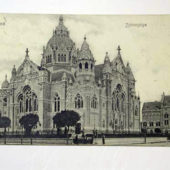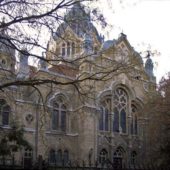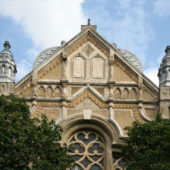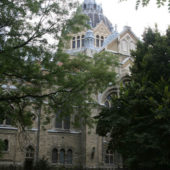Many Hungarians say the Szeged Synagogue is the most beautiful in the world.
Hungary’s second largest synagogue is also a breathtaking masterpiece of religious architecture. Lipot Baumhorn, architect of 22 other Hungarian synagogues, won a design competition for the Szeged synagogue in 1897.
Construction was completed in October 1902, giving Szeged’s burgeoning Jewish population of over 6,000 both a roomy and extravagant house of worship. Baumhorn combined elements of several different architectural styles — Arabic, Moorish and Mediterranean — into the synagogue, while still managing to create an overall harmonious structure. This eclectic mixture today is called Sezession style.
The striking exterior of Baumhorn’s synagogue advertises a Jewish population of strong faith, confidence and prosperity. The building’s dimensions are impressive, soaring to a height of nearly 49 meters (150 feet) a width of 35 meters and length of 48 meters. Inside, the dome rises 32 meters (96 feet) above the main hall. The main floor seats 700 while the second floor galleries seat another 600 people.
A palette of blue, gold and ivory colors help to unify the interior of the building. The focal point, however, is the towering dome that symbolizes the world. Columns supporting the dome feature Hebrew inscriptions emphasizing work, good deeds and culture — foundations of Jewish ethics. Twenty-four columns supporting the dome’s cupola represent the hours of the day while briar bush flowers on a blue background symbolize faith.
Another smaller dome rises above the ark, marking the ritual heart of the synagogue. The ark’s doors are made of shittimwood imported from the banks of the Nile River and a marble table underneath the high altar was used for reading the Torah. Renowned for its acoustics, the synagogue features an impressive organ of 2,317 pipes, 42 registers and 2 keyboards. Built by Wegenstein C. Lipot, the organ was refurbished in 2000-2001. Fruit and floral motifs prominent throughout the synagogue were largely the idea of the synagogue’s rabbi Immanuel Loew, who served from the 1880s until 1944. The rabbi took a scholarly interest in Biblical flora, even producing books on the topic.
The first Jewish families settled in Szeged in the late 1700s and by 1803 they had built a synagogue in town. By the mid 19th Century Jews were granted civil rights in Hungary after which they enjoyed increasing freedom and prosperity though marked by occasional backlashes. By the 1920s, Szeged’s Jewish population was in decline as more Jews, inspired by Zionism, moved to Palestine. Still, there was a sizeable number through World War II. In 1944, the Germans occupied Hungary forcing Szeged’s Jews in a ghetto before deporting them to death camps. The synagogue’s longtime leader, Rabbi Loew, at 90, was put on a train to Auschwitz but was smuggled off in Budapest. He later died in the Jewish ghetto there.
After the war, a few hundred of Szeged’s Jews returned and reclaimed the synagogue from its wartime use as a storage facility. However, the overall community continued in decline for decades. In 1989, after renovations, the synagogue was rededicated. Today there remain several hundred Jewish residents in Szeged. The synagogue sees occasional religious use and also serves as an events center and concert hall.




